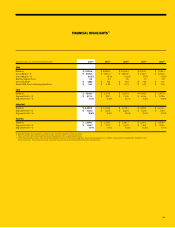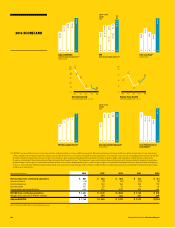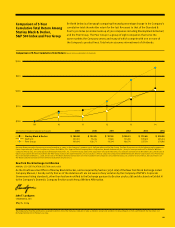Black & Decker 2014 Annual Report Download - page 19
Download and view the complete annual report
Please find page 19 of the 2014 Black & Decker annual report below. You can navigate through the pages in the report by either clicking on the pages listed below, or by using the keyword search tool below to find specific information within the annual report.
5
The CSS business designs, supplies and installs electronic security systems and provides electronic security services, including
alarm monitoring, video surveillance, fire alarm monitoring, systems integration and system maintenance. Purchasers of these
systems typically contract for ongoing security systems monitoring and maintenance at the time of initial equipment
installation. The business also sells healthcare solutions, which includes medical cabinets, asset tracking solutions, infant
protection, pediatric protection, patient protection, wander management, fall management, and emergency call products. The
CSS business sells to consumers, retailers, educational, financial and healthcare institutions, as well as commercial,
governmental and industrial customers. Products are sold predominantly on a direct sales basis.
The MAS business sells and installs automatic doors, commercial hardware, locking mechanisms, electronic keyless entry
systems, keying systems, tubular and mortise door locksets. MAS sells to commercial customers primarily through independent
distribution channels.
Operating Segments – Other Information
Competition
The Company competes on the basis of its reputation for product quality, its well-known brands, its commitment to customer
service, strong customer relationships, the breadth of its product lines and its innovative products and customer value
propositions.
The Company encounters active competition in the CDIY and Industrial segments from both larger and smaller companies that
offer the same or similar products and services. Certain large customers offer private label brands (“house brands”) that
compete across a wider spectrum of the Company’s CDIY segment product offerings. Competition in the Security segment is
generally fragmented via both large international players and regional companies. Competition tends to be based primarily on
price, the quality of service and comprehensiveness of the services offered to the customers.
Major Customers
A significant portion of the Company’s CDIY products are sold to home centers and mass merchants in the U.S. and Europe. A
consolidation of retailers both in North America and abroad has occurred over time. While this consolidation and the domestic
and international expansion of these large retailers has provided the Company with opportunities for growth, the increasing size
and importance of individual customers creates a certain degree of exposure to potential sales volume loss. As a result of the
Company’s acquisition strategy, sales to U.S. home centers and mass merchants declined from a high of approximately 40% in
2002, to 15% before the Black & Decker merger. In 2014, sales to U.S. home centers and mass merchants were 19%. As
acquisitions in the various growth platforms are made in future years, the proportion of sales to these valued U.S. home center
and mass merchant customers is expected to continue to decrease to levels existing prior to the Black & Decker merger.
Working Capital
The Company continues to practice the operating disciplines encompassed by the Stanley Fulfillment System (“SFS”). SFS
has five primary elements that work in concert: sales and operations planning, operational lean, complexity reduction, global
supply management, and order-to-cash excellence. The Company develops standardized business processes and system
platforms to reduce costs and provide scalability. SFS is instrumental in the reduction of working capital evidenced by the 56%
improvement in working capital turns for the Company from 5.9 at the end of 2010 (excluding HHI) to 9.2 at the end of 2014.
The continued efforts to deploy SFS across the entire Company and increase turns have created significant opportunities to
generate incremental free cash flow. Going forward, the Company plans to further leverage SFS to generate ongoing
improvements both in the existing business and future acquisitions in working capital turns, cycle times, complexity reduction
and customer service levels, with a goal of ultimately achieving 10 working capital turns.
Raw Materials
The Company’s products are manufactured using ferrous and non-ferrous metals including, but not limited to steel, zinc,
copper, brass, aluminum and nickel as well as resins. The Company also purchases components such as batteries, motors, and
electronic components to use in manufacturing and assembly operations along with resin-based molded parts. The raw
materials required are procured globally and available from multiple sources at competitive prices. As part of the Company's
Enterprise Risk Management, the Company has implemented a supplier risk mitigation strategy in order to identify and address
any potential supply disruption associated with commodities, components, finished goods and critical services. The Company
does not anticipate difficulties in obtaining supplies for any raw materials or energy used in its production processes.
























